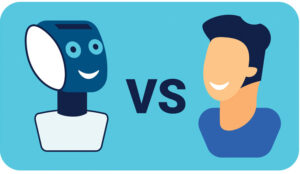Dhruv Mehta, on behalf of injixo, argues that a combination of chatbots and real agents can best serve your customers and boost productivity.
The industrial revolution kickstarted the ‘Man Vs. Machine’ battle. And with the technological revolution being led by artificial intelligence (AI) and machine learning (ML), that battle has only deepened. Chatbots, which are computer software that can mimic human conversations, have risen as the top contenders.
Why Use Chatbots?
At this juncture, we can’t help but pause and reflect on how chatbots have enabled modern enterprises to scale their operations effectively. That brings us to the question — What tasks can they be assigned to make work easier for humans?
Typically, chatbots are made to do repetitive tasks that can be resolved with canned responses, following a specific logical process. In other words, chatbots are used where empathy, intelligence, or advanced cognitive abilities of a human agent are not required.
Here are some benefits that chatbots offer, where they can complement human live chat teams:
1. Quicker Responses
The primary benefit of using an AI-enabled chatbot is that they are quick in responding. Unlike human agents, who have inherent downtimes like working hours, breaks, leaves, holidays, etc., chatbots work round-the-clock without any break. Also, they respond almost in real-time to chat pings.
2. Multi-Lingual Conversations
Being a piece of computer software that can be customized in any manner, chatbots are experts at multilingual conversation exchange. The software can be integrated with language translation APIs and SDKs that will enable the chatbot to automatically detect the language the user is using and respond accordingly.
Additionally, the chatbot can also be configured to offer language choices to the user to begin the interaction.
3. High Scalability
A typical human contact centre agent, even the most productive one, can only handle a limited number of conversations at a time. In fact, anything more than three conversations could hamper the agent’s focus and ability to handle the customer issue properly.
A chatbot, on the other hand, can handle as many conversations as needed without any detrimental effect on the quality of the conversations or productivity.
4. Cost-Effectiveness
Given the fact that a human agent can handle only so many chats at a given time, a contact centre would have to hire more agents to balance the workload. Needless to say, it would inflate the personnel costs and their administration, leaving an undue burden on organizational resources.
Now, a chatbot is a one-time investment and costs only a fraction to acquire and set up. Also, any of the legal statutes of minimum wages and several other contractual obligations that apply to human agents do not apply to chatbots.
5. Continuous Learning
Chatbots are equipped with machine learning capabilities, which help them learn continuously from interactions with customers. The machine learning code creates new neural connections and paths in the chatbot software that enables the software to deliver responses that are attuned to the user’s evolving requirements.
If chatbots are beneficial, in which cases do human agents outperform them?
The Inherent Strengths of Human Contact Centre Agents
Despite all the advantages of chatbots, there are specific circumstances when a human agent will come out on top in providing a better customer experience. Humans have inherent strengths that enable them to outwit chatbots or any form of automation in a live chat situation.
Here is a handful of them:
1. Display of Empathy
Humans are emotional beings. Compared to their chatbot counterparts, human agents are at an advantage in terms of providing emotional support to users who are calling with critical customer support issues. They can use empathy to understand how someone else feels and what they might be thinking.
For example, a customer who calls to report a lost credit card may not want the robotic tone of a chatbot, instead preferring the reassuring verbal communication of a human agent.
2. Experience-Driven
The customer service expertise of a human agent is molded through experiences. They learn how to properly deal with irate, disappointed, and worried customers. A chatbot, even with sentiment analysis, may not be able to bring about these subtle differences in customer service.
3. Culturally Sensitive
Businesses operating in the internet era have customers belonging to diverse ethnicities, cultural backgrounds, and demographics. Cloud computing enables contact centre managers to assemble a virtual team consisting of agents belonging to these diverse cultural backgrounds.
They will be in a better position to deliver customer support that handles the cultural sensitiveness of the issue, which a chatbot may not be good at.
4. Acting with Urgency
A chatbot is designed to work in a specific manner. It may not be able to understand the gravity of the situation and the dire circumstances under which the user is writing. A human agent would be able to pick up these cues that a chatbot will miss out on.
They are in a better position to respond with urgency to put the user at ease.
5. Understanding Human Tonality
Human interactions are garnished with humor, sarcasm, anger, and other such emotional attributes. Of course, sentiment analysis is slowly making chatbots capable of picking up such nuances. However, they are still a far cry when compared to the ability of a human contact centre agent to understand human tonality in a conversation.
It is this understanding that helps a business provide moments of wow and joy to a customer, in addition to quick resolutions.
How Chatbots and Human Agents Complement Each Other
We have seen that chatbots and human agents each have specific strengths that make them particularly successful in certain scenarios. Here are some examples how chatbots and agents can work effectively side-by-side.
1. Automating Basic Tasks
Contact centres get all types of customer calls and queries. And a vast majority of them could be basic queries that may not require the time and effort of a human agent. A chatbot can automate such tasks, thus sparing the agent, so they can look after high priority tickets that deserve their time and effort.
For example, in a bank’s contact centre, a chatbot can be used to provide customers with their latest account balance or details of the last five transactions.
2. Prioritizing Sensitive Tickets
A chatbot can act as a frontline customer support tool that collects customer queries and buckets them based on priority. For support tickets that are labeled as critical or emergency, a human agent can be looped in to address it. The result would be the proper prioritizing of sensitive tickets to deliver timely support to customers.
3. Load Balancing for Human Agents
As mentioned earlier in this article, there is a threshold for human productivity. It cannot be pushed beyond a limit. Chatbots help balance the workload for human agents by handling low-priority queries that are high-volume in nature.
As a result, human agents would be able to showcase better productivity in resolving customer queries.
Final thoughts: How Chatbots + Human Agents Augment Productivity In a Contact Centre
A contact centre is a business function where the machine memory of a chatbot and the human skills of an agent can be brought together for maximizing business efficiency. Every contact centre manager strives to maximize the FCR (First Contact Resolution) rate and reduce the AHT (Average Handling Time) of calls.
But, this can’t be achieved with human agents alone. They must be provided with the right set of tools that will automate the heavy chunk of low-value work. In other words, chatbots can be used to segment the first layer of customer queries so that they can be channeled to the right agent or team of agents who are trained and specialized in attending to them.
Chatbots can also be used to ensure that there is accuracy in the information being served to customers. In addition to customer-facing bots, the contact centre team can also have a bot that serves information to the agent to help solve the ticket faster.
There is one more case of chatbots and agent integration that will delight contact centre managers. It is the use of bots to tackle holiday season spikes. Chatbots can be trained to route holiday-specific business queries to specific teams in other time zones, which are free to handle them.
This helps the contact centre offset the void that agents going on vacation might create.
In a nutshell, a contact centre can’t work optimally with only a chatbot. Neither is it advisable to run a contact centre with human agents alone. There should be an ideal combination of both forces so that productivity can be maximized and cost efficiencies can be achieved.
Author: Robyn Coppell
Published On: 26th Mar 2020
Read more about - Guest Blogs, Peopleware






































